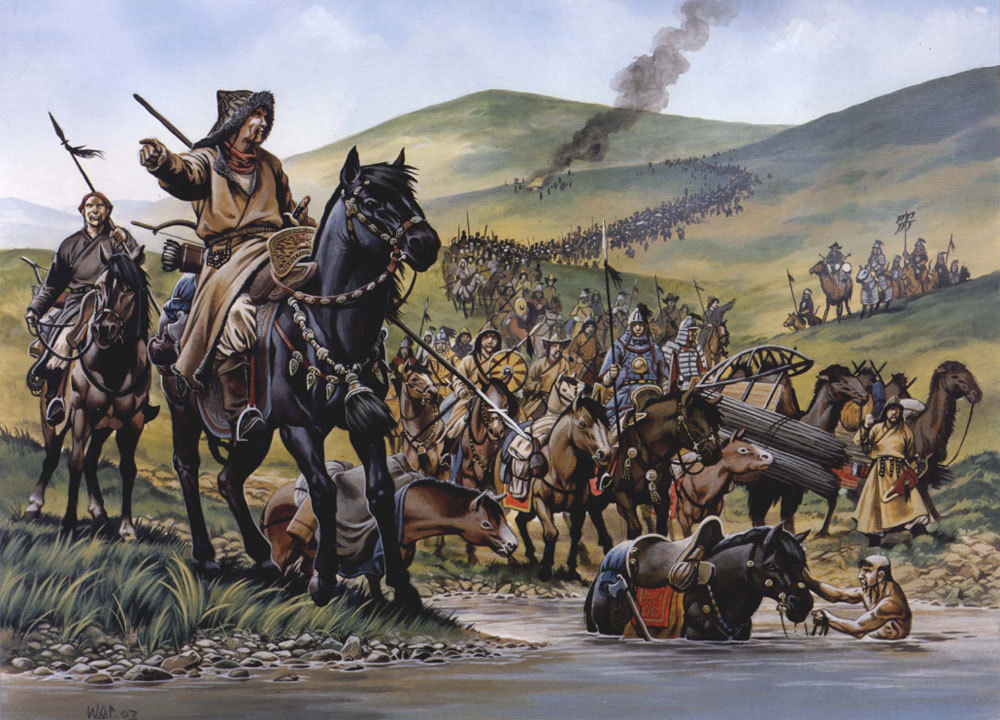From 1206 to 1368, Mongol armies galloped across Eurasia, toppling kingdoms from Korea’s far shore to the frontiers of Poland and Egypt. On land they were almost unstoppable: swift cavalry, ruthless discipline, brilliant siegecraft. Rivers even helped them—most famously in 1258, when boats on the Tigris ferried siege engines that helped bring Baghdad to its knees. But the open ocean was different. There, the world’s greatest land empire met its limit.
When the Steppe Met the Sea
Kublai Khan believed Japan should acknowledge his supremacy. Diplomacy failed—envoys were killed—and the Khan turned to force. In the autumn of 1274, a fleet of roughly 900 Korean and Chinese ships carried about 30,000 soldiers to Hakata Bay on Kyushu. The Mongols fought hard and won ground ashore, yet the invasion soon began to unravel. Supplies had to cross the rough East China Sea; coordination among Mongol, Chinese, and Korean contingents was uneven; and many transports—flat-bottomed and hastily built—were never meant for blue water or sudden storms.
The storm came. As the fleet clustered at anchor, a typhoon smashed the crowded moorings, capsized ships, and hurled others onto rocks. Thousands drowned. The survivors withdrew, and Japan remained unconquered.
A Second Attempt, a Second Catastrophe
Defeat only hardened Kublai’s resolve. He ordered larger, ocean-worthy ships and planned a far bigger invasion: two armadas—more than 4,000 vessels and over 140,000 men—would converge again on Hakata Bay. The plan aimed to avoid the worst of typhoon season, but the sea has its own calendar. The Korean fleet attacked early on June 23, 1281; the Chinese fleet, fighting adverse winds and currents, arrived weeks late. As the invaders lingered offshore, Japanese defenses and relentless coastal raids wore them down.
In August, the weather turned once more. A second great typhoon tore through the combined armada, wrecking countless ships. Many who reached shore were hunted down. The “divine wind” ended Mongol ambitions in Japan for good.
Southward to Java—And Another Lesson
In 1293 the pattern repeated in new waters. After Javanese leaders rejected Kublai’s demands and mistreated his envoys, a punitive expedition sailed into the South China Sea. Initial successes could not conceal deeper problems. The archipelago’s humid heat, tangled inlets, shifting tides, and narrow channels favored local seamanship. Javanese forces exploited every current and mangrove, while Mongol logistics stretched thin. By late summer, the expedition withdrew with heavy losses.
Why the Oceans Won
What the Mongols lacked at sea was not courage but craft. Ocean warfare demanded sturdy ships built for storms, steady resupply without secure coastal bases, and a unified naval command that could wait for the right wind rather than the next charge. Japan’s fortifications and night raids, Java’s mastery of local waters, and—above all—unpredictable typhoons exposed an empire designed for speed across grass, not survival on the swell.
Conclusion
The Mongols proved that the steppe could conquer cities and kingdoms with astonishing speed. The seas around East and Southeast Asia proved something else: geography, weather, and local knowledge can stop even the mightiest machine of war. Where rivers had carried the invaders forward, the oceans finally carried them no farther.










































